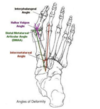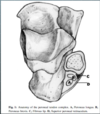Foot & Ankle Flashcards
Where are the Lisfranc Joints Located?
Between midfoot and forefoot (between metatarsals and cuneiforms/cuboid)

Where are the chopart joints located?
Between the hindfoot and midfoot (between talus &calcaneus, and the navicular & cuboid

List the Ligaments of the Syndesmosis
- Anteroinferior Talofibular Ligament (AITFL)
- Posteroinferior Talofibular LIgament (PITFL)
- Inferior Transverse Ligament (ITL)
- Interosseus Ligament (IOL)
- Interossesus Memebrane

Which tendons attach to the talus?
None
What are the facets/parts of the Talus?
- Parts: Head, Body & Neck
- Facets: Anterior, Medial, Posterior
Describe the Arteries Providing Blood Supply to the Talus (6)
- Artery of the Tarsal Canal
- From Posterior Tibial A.
- Supplies Body
- Deltoid Artery
- From Artery of the Tarsal Canal
- Supplies Medial Body
- Direct Posterior Artery
- From Peroneal Artery
- Supplies Posteiro Process/Body
- Direct Superomedial Artery
- From Dorsalis Pedis
- Supplies Head & Neck
- Artery of the Tarsal Sinus
- From the Dorsalis Pedis & Peroneal A
- Supplies Neck & Lateral Body
- Perforating Peroneal A.
- From Peroneal A.
- Supplies Head & Neck
In general:
- Dorsalis Pedis A. - Supplies Head & Neck
- Peroneal A. - Supplies Head & Lateral Body
- Posterior Tibial A. - Supplies Tarsal Canal A. & Medial Body
- The main blood supply to the talus

Describe the location, boarders and contents of the Sinus Tarsi
- Location: Just distal to the tip of the fibula between the posterior and middle facets
- Boarders
- Superior: Talus
- Inferior: Calcaneus
- Anterior: Talocalcaneonavicular Joint
- Posterior: Posterior facet of subtalar joint
- Contents:
- Sinus Tarsi A.
- Tarsal Canal A.
- Cervical Ligament
- Interosseus Talocalcaneal Ligament
- Medial, Intermediate Lateral origins of plantar retinaculum.
- Fat
Parts of the Calcaneus
- Anterior Facet
- Middle Facet (on sustentaculum)
- Posterior Facet
- Anterior Process (articulates with cuboid)
- Calcaneal Tuberosity
What is the main motion at the Chopart Joints?
Abduction/Adduction
List the Ligaments of the Tarsometatarsal (TMT) Joints
- Transverse Ligaments: attaches base of metatarsals 2-5 (none between 1&2)
- Longitudinal Ligaments (connects base of MT to midfoot cuneiforms or cuboid)
- Oblique Ligament (From medial cuneiform to base of 2nd metatarsal)
- aka LISFRANC LIGAMENT
What are the components of the Lisfranc Ligament? Which is strongest? Weakest?
- Dorsal - weakest
- Interosseus - true “lisfranc ligament”. Strongest.
- Plantar

Describe the mechanism for Hallux Valgus.
- Failure of medial ligments (MCL and medial sesamoid)
- Valgus at joint, sesamoid subluxes laterally
- Medial sesamoid sits on cristae and further erodes it causing further lateral subluxation and valgus deformity at MTP joint
- EHL & FHL move lateral to the axis of the ray, worsening the deformity
- EHL, FHL, Add Hallicus overpower the foce of Ab Hallicus further causing valgus deformity

Describe the Angles Measured in Hallux Valgus
- Intermetatarsal Angle (IMA) - angle between 1st & 2nd metatarsals.
- Normal <= 9 degrees
- Hallux Valgus Angle (HVA) - angle between 1st metatarsal and proximal phalanx D1
- Normal <= 15 degrees
- Distal Metatarsal Articular Angle (DMAA)- Between 1st MT long axis and line along base of distal articular cap
- Identifies MTP joint incongruity
- Normal <= 10 degrees
- Hallux Valgus Interphalangeus Angle (HVI): between long axis of distal phalanx and proximal phalanx
- Normal <=10 degrees

What is the order of tendons crossing the ankle joint anteirorly, from medial to lateral?
- Tibialis Anterior
- EHL
- EDL
- Peroneus Tertius

What is the order of tendons crossing the ankle posteriorly from medial to lateral?
- Plantaris
- Achilles

What is the order of tendons behind the medial mallolus from ant to post, medial to lateral?
- Tibialis Posterior
- Flexor Digitorum Longus
- Flexor Hallicus Longus

*Tom Dick & Harry
What is the Knot of Henry?
- Distal crossing of FHL and FDL in the foot
- Important site for graft harvest
- FHL comes medial to FDL, FDL corssess superifical to FHL.
- Tendon sheaths communicate at the knot

Where is Kager’s Fat Pad?
Fat pad anterior to the achilles tendon.
What is the order of the tendons crossing the ankle laterally both above and below the ankle.
- Above ankle: peroneus longus superficial to peroneus brevis
- Distal to fibula: brevis is anterior to longus
- They share a common sheath proximally but split into individual sheaths distally

What are the primary restraint to lateral instabiliy of the peroneal tendons? Where are they located?
- Superior Peroneal Retinaculum
- Primary restraint
- 3.5mm proximal to the tip of the fibula
- Inferior Peroneal Retinaculum
- Distal over the lateral wall of the calcaneus

What are the components of the fibroosseus tunnel of the posterior fibula.
- Posterior Fibular Groove
- Fibrocartilage Ridge
- Superior Peroneal Retinaculum
- Ligaments
- CLF
- PITFL
- PTFL
Contents:
- Peroneus Longus & Brevis

What are the boarders of the contents of the tarsal tunnel?
- Tarsal Tunnel:
- Fibroosseus tunnel formed by:
- Posterior medial malleolus
- Medial wall of calcananeus & talus
- Flexor retinaculum
- Fibroosseus tunnel formed by:
- Contents
- Tibialis Posterior
- FDL
- Posterior Tibial A. & V.
- Tibial N.
- FHL
*Tom Dick & Very Nervous Harry
List the Lateral Ligaments of the Ankle. What stresses do they combat?
- Anterior Talofibular Ligament (ATFL)
- Lateral malleolus to neck of talus
- Resists anterior translation
- Most commonly injurued
- Calcanofibular Ligament (CFL)
- Peroneal tubercle of calcaneus to tip of fibula
- Deep to peroneal tendons
- Resists inversion forces
- Posterior Talofibular Ligament (PTFL)
- Lateral mallelleolus to lateral tubercle of posterior process of talus
- Resists dorsiflexion and inversion forces
In which postion are ATFL, CFL and PTFL the tightest?
- ATFL: plantarflexion
- CFL: Inversion
- PTFL: Dorsiflexion





